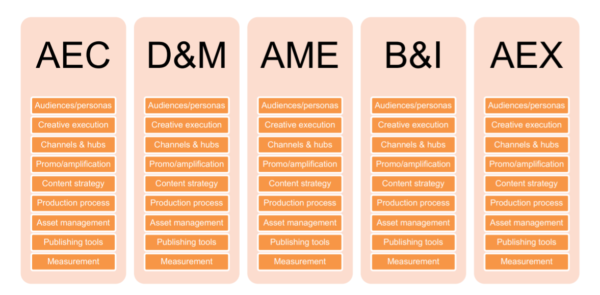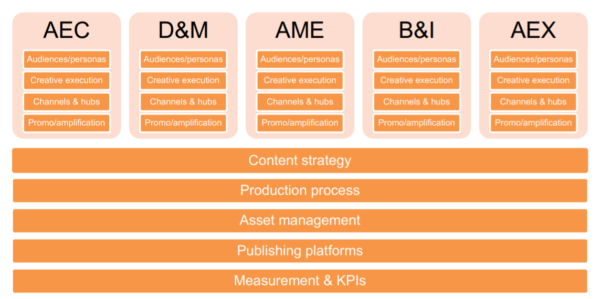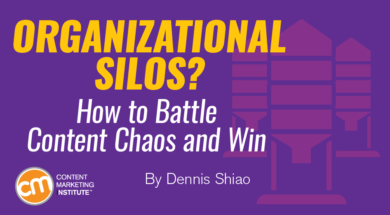 It’s the middle of an all-hands meeting; the newly appointed chief marketing officer at Autodesk said: “Dusty’s going to fix the content problem.”
It’s the middle of an all-hands meeting; the newly appointed chief marketing officer at Autodesk said: “Dusty’s going to fix the content problem.”
Dusty?
Dusty DiMercurio, the director of content marketing and social media at Autodesk, and the hero of this story, asked himself, “Hmm, I wonder what that means to her?”
Dusty shared the story of how he learned about and addressed the challenge in a ContentTECH Summit presentation, From Tech Chaos to Content Coordination: Organizing for Success in the Enterprise.
Our hero was presented with a formidable task: to wrangle with the chaos that results from large teams operating in silos. (Autodesk has over 10,000 employees worldwide and uses a decentralized model for delivering content.)
Our hero scopes out the content problem
Dusty’s first step? Dive into the depths of the chaos to understand what makes it thrive. He met with all levels of the organization to understand their involvement in the content development process.
Battle #content chaos: Step 1. Meet w/ all levels to understand their role in content dev. @dustycd #ContentTECH Click To Tweet
Here’s what he learned:
- CMO didn’t have visibility or an understanding of who’s creating content within the organization and what content types they’re creating. She was unsure whether the content was used and if efforts were duplicated.
- Vice presidents wanted to know the cost for content, the ROI, and what better efficiencies the teams could do.
- Directors didn’t see what the content production line looked like and wanted visibility around that. They also wanted to know how existing content could be made to work harder rather than continually creating new content.
- Managers and individual contributors wanted to see more of what peer groups were doing – what was working and what lessons they could learn from their successes.
Going further – beyond people and process – Dusty also inventoried the software tools across the organization. This image shows a portion of those tools:
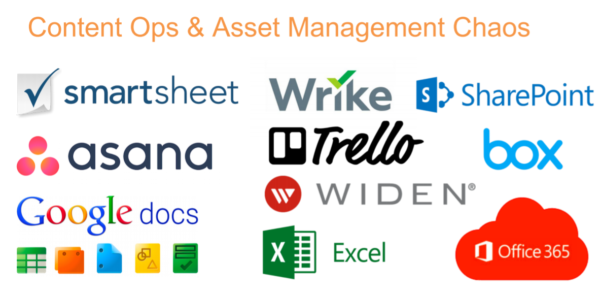
This inventory led our hero to realize that technology was another villain in the battle. Different teams used different tools to accomplish different tasks. Dusty concluded that the organization was overinvested in technology and in some areas was using redundant tools. To address this chaos, Dusty and the team needed to step back and reconcile the content technology stack.
At the conclusion of his scoping, Dusty assembled the following action plan:
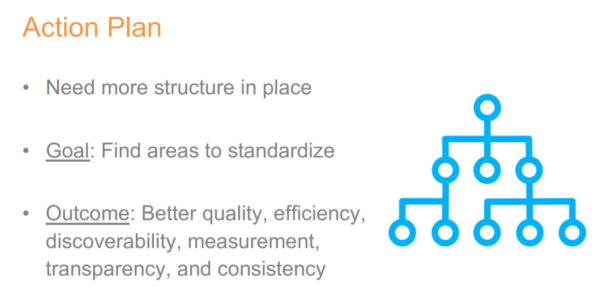
“We needed to figure out ways where we can standardize, so that we can get better quality, efficiency, and discoverability,” Dusty says.
Know where to standardize #content creation to improve quality, efficiency, discoverability. @dustycd #ContentTECH Click To Tweet
The first step? Analyze how to organize the teams around the content creation process.
Organize content development teams
Like Batman and Robin, heroes need to band together to battle their most feared villains. Dusty presented his question to CMI’s Robert Rose: How do companies, especially large companies, organize around content?
Robert and Dusty discussed three models:
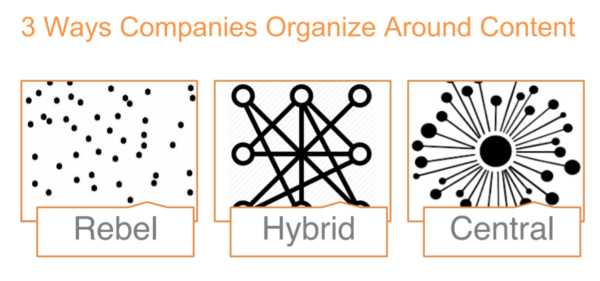
- Rebel: A decentralized model where content teams work independently with limited coordination across teams. Autodesk was operating in this model.
- Central: A single team works across business units to receive and deliver requirements related to content creation.
- Hybrid: Use a blend of the rebel and central models.
Here’s the point in our story where we compare Dusty, our hero, to a character in a riff of a James Dean movie, Rebel With A Cause. The cause? To move the organization from the rebel model to a central or hybrid one.
To make the move, Robert told Dusty, the organization would need a common narrative – one story all groups could rally around. As Dusty says, “Our audiences are different, but we do have a singular narrative around helping people design and make things, whether it’s a film, a car, a building, or a part for a product.”
An org needs a common narrative – one story all groups can rally around, says @Robert_Rose. #Storytelling Click To Tweet
Coming from a rebel model, Dusty thought a central model would be too challenging a move. He opted for a hybrid model. They called the effort “Project Charlie.”
Adopt a hybrid content creation model
Here’s a picture of Autodesk’s content creation process before Project Charlie:
The functional elements of content creation were duplicated across each business unit. Dusty explains: “These teams are all managing their own audiences; they’ve got their own creative execution, promotion, amplification. They’re managing their own channels. They’ve got their own measurement capabilities and publishing tools. It’s messy, right?”
To adopt a hybrid model, Dusty and the team selected which functions to centralize and which functions would still be duplicated across business units. The hybrid model looked like this:
Autodesk created a strategy to centralize a number of services. It’s currently in the midst of implementing this strategy. Dusty and team selected the following services to centralize:
Benefits from shared services
You might think Project Charlie was primarily about satisfying core team members by moving functions to a centralized model. While that’s one aspect, the key benefits come from the shared services, which bring efficiency and consistency to content creation across the organization:
Shared services bring efficiency & consistency to #content creation across the org, says @dustycd. #ContentTECH Click To Tweet
- Shared strategy: An aligned customer journey allowed the development of a common language to describe Autodesk customers and to detail where they are in the customer journey. “If you have an aligned journey, it helps you identify different gaps where you have no content, but need some, as well as areas where you’re creating too much content,” Dusty says.
- Shared production process. Remember the image of vendor logos earlier? A shared production process consolidates tools. The result? “More transparency into the process of creating content across teams, where you can share learnings,” says Dusty. In addition, aligned planning gives visibility into what other groups are working on.
- Shared asset management. Instead of storing content in a lot of distinct repositories, Dusty and team standardized on a digital asset management system with Widen, a DAM tech solution. “A shared asset management strategy and common tagging makes it easier for people to find content and easier for us to track what’s getting used and what’s not,” Dusty says.
- Shared publishing tools provide for easier delivery and better coordination. The shared tools help when a crisis arises because teams can better coordinate a response.
- Shared measurement and KPIs allow for common goals and easier analysis. According to Dusty, “It can start to incite a little bit of internal competition, which is great because then you’re going to have your teams trying to outperform each other.”
HANDPICKED RELATED CONTENT:
Tackle the next set of challenges
A hero’s work is never done.
While Project Charlie helped Dusty accomplish the chaos-wrangling mission set forth by the CMO, more challenges lie ahead and more villains arise to battle. What’s next up for our hero?
- Global expansion. Our hero conquered one kingdom. Next step? Global domination. While Dusty’s focus has been on the North American market, he’s now building a team in Europe, the Middle East, and Africa (EMEA), and one in the Asia Pacific region. “It gets more complicated when you’re trying to scale content across an organization and across regions,” Dusty says.
- Account-based marketing (ABM). Content marketers must think differently about how they serve their target audience. “The funnel is reversed, where you think about building a content strategy for a single, really important account. Build a holistic integrated content strategy for that account, and then execute it against that account,” Dusty says. You can reuse some assets for accounts with a similar profile (e.g., in the same industry and facing the same set of challenges).
HANDPICKED RELATED CONTENT:
Is your team a rebel, central, or hybrid?
My content marketing roles have been at small- to-mid-size businesses of roughly 100 employees. We had a central model, where we served the needs of the business from a single function. In fact, I spent time working as the sole employee responsible for content marketing.
I can see why larger organizations, on the other hand, end up in a rebel model. While Autodesk didn’t choose to operate in a rebel model, that’s where they ended up, because groups worked in silos with no aligned strategy. With the help of our hero, they realized that some things could be centralized, which would increase efficiencies, as well as improve overall content quality.
What model does your organization employ and what are the benefits and drawbacks?
If you’re in a large organization using a rebel model, do you see the benefits of moving to a central or hybrid model? Use the comments section below to share your perspectives.
Here’s an excerpt from Dusty’s talk:
Improve your content creation and production model. Learn from dozens of experts at Content Marketing World Sept. 3-6. Register today using code CMIBLOG100 to save $100.
Cover image by Joseph Kalinowski/Content Marketing Institute
